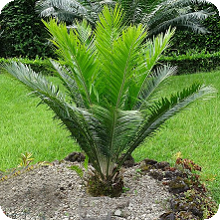|
| Division: Cycadophyta |
| Class: Cycadopsida |
| Order: Cycadales |
| Family: Zamiaceae |
| Genus: Encephalartos |
| Species: E. aplanatus |
Conservation Status: |

E. aplanatus
Vorster's CycadEncephalartos aplanatus is a shade-loving cycad that closely resembles E. villosus. The leaflets of E. aplanatus, however, tend to be wider than those of E. villosus and the two species are also geographically separated. It occurs naturally in the north-eastern part of Swaziland in the shade of deciduous trees, in fairly dry ravine forest. Only one colony is known to exist. E. aplanatus is easy to grow but is not common in cultivation.
This species usually has a single subterranean stem with an exposed apex. Unlike E. villosus, E. aplanatus does not sucker. It usually produces 2 to 8 erect, arching leaves up to 3.5 m long which sag horizontally with age. Leaves have a petiole up to 200 mm long. The lower rachis is covered with a whitish indumentum. Mature leaves are dark green and glossy, the leaflets twisted and undulating. The leaflets are directed towards the apex, and opposing leaflets are at 180 degrees to each other. Lower, proximal leaflets progressively decrease in size, finally reduced to prickles. Median pinnae are up to 300 mm long, 40 mm wide, narrowly ovate, tapering to an acute tip with both margins sparsely dentate, very rarely entire.
Male plants produce up to three cones, green when young, turning yellow when mature, up to 650 mm long and 80 to 100 mm in diameter, with a peduncle up to 220 mm long. Pollen is shed from the smooth, hairless microsporophylls in mid autumn.
Female plants produce one to two cones up to 400 mm long and 120 mm in diameter. Peduncles are short and stout and up to 60 mm long. The exposed faces of the megasporophylls are flat, smooth and hairless, with indistinct facets armed with sharp abaxial ridges. Female cones appear in mid-summer (January) and disintegrate in early to mid-spring. Seeds are ellipsoid, about 25 mm long and 13 mm to 15 mm in diameter. The sarcotesta is bright red.
Cultivation:
Encephalartos aplanatus is easily grown from seed. Cycad seeds are toxic to humans; one should therefore use gloves when handling or cleaning them.
Hand-pollination is necessary to ensure viable seed from plants in cultivation. Pollen can be collected as soon as it starts shedding. Male cones are ready to be harvested when a slight tapping of the cone sheds pollen. Pollen should be stored at -15°C for best results. The scales of the female cones have to be closely monitored as the window of their opening is variable from plant to plant and only lasts from three days to two weeks. Wet hand-pollination, using pollen in distilled water administered by a syringe, can give a good pollination rate.
After female cones have been collected, the seed is left to mature for a year before sowing at the beginning of summer. For best results, seed is sown in river sand on a heated bench at 24-28°C. Germination usually starts about three weeks after sowing, but may take longer. E. aplanatus is relatively fast-growing and easy to transplant.
| shade | dark green | low watering | fast growth | frost-sensitive | common |
Encephalartos aplanatus is easily grown from seed. Cycad seeds are toxic to humans; one should therefore use gloves when handling or cleaning them.
Hand-pollination is necessary to ensure viable seed from plants in cultivation. Pollen can be collected as soon as it starts shedding. Male cones are ready to be harvested when a slight tapping of the cone sheds pollen. Pollen should be stored at -15°C for best results. The scales of the female cones have to be closely monitored as the window of their opening is variable from plant to plant and only lasts from three days to two weeks. Wet hand-pollination, using pollen in distilled water administered by a syringe, can give a good pollination rate.
After female cones have been collected, the seed is left to mature for a year before sowing at the beginning of summer. For best results, seed is sown in river sand on a heated bench at 24-28°C. Germination usually starts about three weeks after sowing, but may take longer. E. aplanatus is relatively fast-growing and easy to transplant.
E. aplanatus for sale at AfricaCycads.com:
